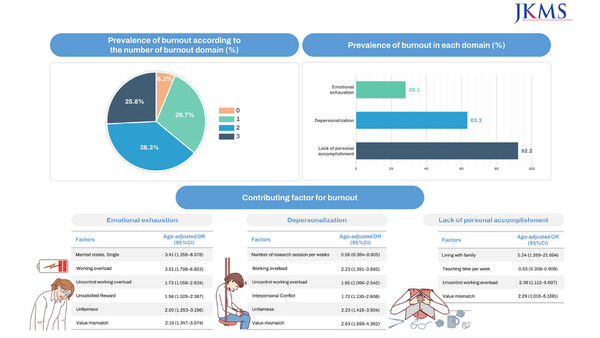Many doctors suffer from burnout. Their prevalence of burnout is higher than in the general population.
The same applies to internal medicine specialists in echocardiography at university hospitals. They work hard and take short breaks, which leads to burnout.
The Heart Imagers of Tomorrow (HIT) committee of the Korean Society of Echocardiography surveyed 128 echocardiographers working in university hospitals. The HIT committee recently published a paper titled “Evaluation of Burnout and Contributing Factors in Imaging Cardiologists in Korea” in the Journal of Korean Medical Science (JKMS), an international journal.

Last November, researchers surveyed internal medicine specialists in echocardiography, including cardiology, at university hospitals. A total of 128 internal medicine specialists participated in the survey, all members of the Korean Society of Echocardiography. Some 60.2% of them have been practicing for more than 10 years. Ninety-three percent of all respondents worked in teaching hospitals, and 36.8 percent worked in institutions with more than 1,000 beds.
Ninety-five respondents (74.2 percent) reported interpreting more than 50 echocardiograms per day. Thirteen (10.2 percent) performed more than 200. In addition, 53.2 percent spent at least five of their 10 weekly shifts working on echocardiography studies, and 47.7 percent worked on Saturdays, either in outpatient clinics or the echocardiography lab.
Their use of annual leaves was low. Thirty-nine percent of respondents took seven or fewer vacation days in a year, and only 10.9 percent took more than two weeks of vacation.
Burnout prevalence was high. The researchers divided burnout experiences into emotional exhaustion, depersonalization, and lack of personal fulfillment. They found that 92.2 percent of respondents reported experiencing a lack of personal fulfillment, followed by 63.3 percent undergoing and 28.1 percent citing emotional exhaustion. Notably, 25.8 percent reported experiencing all three.
Younger age groups were at higher risk for emotional burnout.

Emotional burnout and depersonalization were more likely to be experienced by those aged 45-50 and decreased among those 50 and older. Half of 46-50-year-olds reported emotional burnout, compared to only 9.5 percent of 51-55-year-olds. None of the respondents were 56 or older. Depersonalization was also reported by 85.0 percent of 46-50-year-olds but dropped to 57.1 percent of 51-55-year-olds and 50.0 percent of 56-60-year-olds. More than 90 percent of respondents under 56 also reported a lack of personal fulfillment.
“The heavy workload may be due to the structure of tertiary care organizations. In tertiary care centers, which often teach hospitals, faculty members fulfill multiple roles, including clinical care, research, teaching, and administrative duties. The responsibility of managing multiple roles results in a significant workload and increases the risk of burnout,” the researchers wrote.
Persistent burnout is associated with serious mental health problems, including depression, anxiety, and chronic stress, the researchers concluded.
“The workload issues identified as risk factors in this study need to be addressed in the long term,” they said. “It is important to assess and support professionals' values and subjective factors to prevent burnout effectively."

